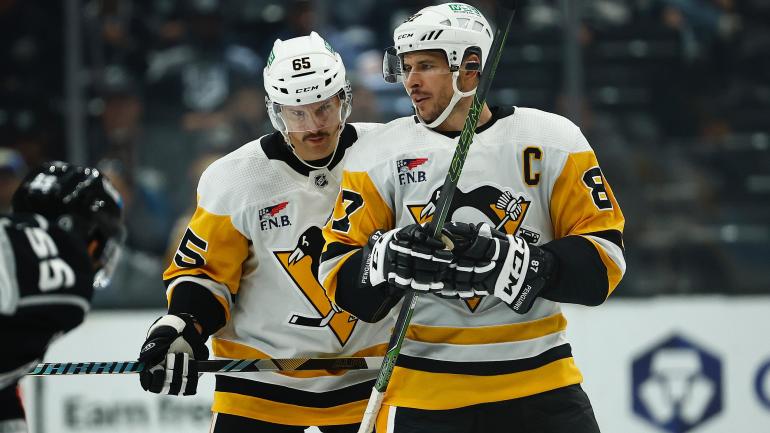
Despite making some notable upgrades in the offseason, the Pittsburgh Penguins find themselves outside of a playoff spot with just 30 games left in the regular season. The Penguins tried to make one more Stanley Cup run with their current core, but a couple of fatal flaws have prevented them from becoming a true threat.
Over the summer, new general manager Kyle Dubas made a pair of splashes on the trade market. He acquired 2023 Norris Trophy winner Erik Karlsson from the San Jose Sharks and added winger Reilly Smith from the Vegas Golden Knights, fresh off a Stanley Cup run. Those two moves made the Penguins more imposing on paper, but it hasn't played out that way on the ice.
As good as the top of its lineup is, Pittsburgh has had trouble finding reliable depth for several years now. That problem has become even more glaring in 2023-24, with the top players shouldering a heavy burden. If players like Crosby, Evgeni Malkin and Jake Guentzel aren't rolling, the Pens struggle to pick up points.
While the depth situation is less than ideal, it would be less of a problem if the Penguins could get some production out of their power play. Instead, Pittsburgh has one of the worst power play units in the league, which is pretty shocking given the amount of skill on their top unit. An anemic man advantage is costing the Penguins points, and it may wind up costing them a playoff spot.
Let's dive deeper into each of those problems, see if there are solutions, and determine where the Penguins should go from here.
Depth
Having a quintet that includes Crosby, Malkin, and Guentzel up front to go along with Karlsson and Kris Letang on the back end is a good start for any team. The catch is that they can't play all 60 minutes, so Pittsburgh needs more players who can put some goals on the board while those five are catching their breath.
It also means that injuries hit the Penguins harder than some other teams, and they just announced that Guentzel will miss the next four weeks with an undisclosed injury. That only makes the lack of depth more pronounced.
Through the first 51 games of the 2023-24 season, Crosby, Guentzel, Malkin and Bryan Rust are the only Penguins pacing for 20 goals. Those four have combined to score 84 goals, which is 56.4% of Pittsburgh's total offensive output.
Outside of those players in the top six, creating offense has been a slog for this team. Smith is the only other player with double-digit goals (10), and no one has produced at a consistent rate. Valtteri Puustinen is fifth on the team in points/60 at 1.99, which is tied for 191st in the NHL among players with 200 minutes played, per Natural Stat Trick. Karlsson is sixth at 1.81, which ranks 235th in the league. That is not a recipe for making the playoffs - and certainly not for winning a Stanley Cup.
Unfortunately for the Penguins, there don't seem to be any easy fixes for their lack of depth scoring. They're right up against the salary cap, so acquiring help via trade would be incredibly difficult. Besides, spending future assets in an attempt to get this team into the playoffs might be a fool's errand anyway (more on that later).
Internally, the bottom of the lineup just is what it is at this point. The Penguins could hope that Rickard Rakell and Karlsson kick it up a notch down the stretch, which is entirely possible. Karlsson's production has fallen sharply in his first season with the Pens, and Rakell just totaled 28 goals and 60 points last season.
If that doesn't happen, the Penguins' offense may only keep backsliding with Guentzel on the shelf.
Power Play
There were questions about the Penguins' depth coming into the season, but with the amount of talent on the top unit, the power play should have been a strength. Instead, it's been an anchor dragging the team down the Eastern Conference standings.
Last season, the Pens' power play scored on 21.7% of its opportunities, which ranked 14th in the NHL. With Karlsson being added to the mix in 2023-24, the thought was that number should only improve this year, but now Pittsburgh would take anything north of 20.0% in a heartbeat.
Crosby, Guentzel, Karlsson, and Malkin have all played at least 196 minutes on the power play this season, and that seems like it would be a lethal combination, especially when adding Letang or Rust on that top unit. Instead, Pittsburgh ranks 30th with a 13.7% conversion rate with the man advantage.
The power play woes have been a team effort, but Malkin is the player stuck in the deepest rut. That's unfortunate for Pittsburgh because Malkin seems to be the main point of focus on the power play. His 15.9 shots/60 with the man advantage are the most on the team and three more than the 12.7 shots/60 he was taking last season.
Despite those extra shots, Malkin is on pace to finish the season with roughly five power play goals. That's less than half the 11 power play tallies he had in 2022-23.
Of course, the power play isn't lagging just because Malkin isn't scoring. Guentzel is shooting at a slightly higher rate this year too, and he is on pace for just six power play tallies after notching 11 last year.
To top it all off, Karlsson hasn't exactly been a power play wizard from the point. On a horrendous Sharks team last season, Karlsson notched five goals and 22 assists with the man advantage. Despite a massive upgrade in the talent around him, Karlsson has scored just twice and added only 11 assists in 2023-24. That is a sharp dip in production and certainly not what Dubas was hoping for when he landed Karlsson last August.
The power play has cost the Penguins valuable points in the standings, especially in tight contests. Pittsburgh has won just seven of its 22 one-goal games, and that number would likely be higher if the power play was operating at even a league-average clip.
The Pens have lost four of their last five games, and three of those defeats have come by just one goal. In the four losses, the Pittsburgh man advantage has converted on just two of its 16 chances.
When looking at possible solutions, the best shot the Penguins have at turning things around on the power play is probably hoping that their puck luck improves to a certain degree because changing schemes with 30 games left doesn't seem like a good idea either.
According to Natural Stat Trick, the Penguins' power play is generating expected goals at the seventh-highest rate in the NHL. In spite of that, Pittsburgh ranks last with an 8.48% shooting percentage on the power play.
The power play may be bad, but I would still expect a unit with that much finishing talent to score at higher than a 9.0% clip on the man advantage. Regression might be the Penguins' only chance at this stage.
What's next for the Penguins?
Following their 2-1 loss to the Los Angeles Kings on Sunday, the Penguins are now seven points out of the second wild card spot in the East. The bigger problem is that there are three teams between them and the Detroit Red Wings, the team currently occupying that final playoff spot.
Pittsburgh has a lot of climbing to do and just 30 games to get there. The playoffs look like more of a longshot with each passing day, and the trade deadline is only a couple of weeks away. That puts Dubas in a tough position.
Maybe Dubas could buy and give Pittsburgh a better shot at the playoffs, but that still wouldn't guarantee a playoff berth, nevermind a Stanley Cup run.
The smarter route might be that of the seller, and the Penguins would have the most coveted player of the trade deadline in Guentzel, who is set to be an unrestricted free agent this summer.
Pittsburgh, already one of the NHL's older teams, might not want to sign the 29-year-old Guentzel to a long-term deal at $7 million per year or higher. Instead of watching Guentzel walk in free agency - and getting nothing in return - the Pens would be wise to see what they could get for him on the trade market.
It's not everyday that 40-goal scorers become available, so the list of suitors for Guentzel would be long. Pittsburgh might have to retain some salary to deal him to a cap-strapped contender, but that would only drive up the price.
If you're looking for an example of what the Penguins might be able to get for Guentzel, the Timo Meier trade from last season might provide a blueprint. Meier, albeit a little younger and healthier than Guentzel, was also a highly-coveted scoring winger.
The Sharks wound up getting a pair of first-round picks, a roster player, and a couple of prospects from the New Jersey Devils in exchange for Meier. If the Penguins get something in that ballpark, it would probably be worth pulling the trigger on a Guentzel deal. Even if Pittsburgh has no interest in rebuilding with Crosby around, it could use those future assets and cap space to retool the roster heading into 2024-25.
From an organizational standpoint, trading Guentzel may be difficult. As a rookie in 2016-17, Guentzel was key in helping the Penguins win their second consecutive Stanley Cup, and he has been a perfect fit alongside Crosby. That said, Guentzel will be 30 when the 2024-25 season begins, and the Pens probably don't want their top eight highest-paid skaters to be over the age of 30.
The other option the Penguins have prior to this year's trade deadline is to deal Smith, whom they just acquired from the Golden Knights last offseason. Smith had a strong start to the season, but he has slowed down quite a bit since. Despite that, Pittsburgh might be able to recoup a mid-round pick from a playoff team in need of depth scoring, but it would be nothing compared to a potential return for Guentzel.
Things have gone stale for the Penguins, now on the verge of missing the playoffs for the second consecutive season. As tough as parting with Guentzel might be, it would give the team more flexibility to make some changes and give Crosby and Co. one more bite at the apple.

















